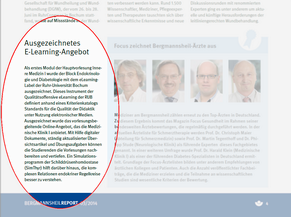Dietrich, J. W. (2002). Der Hypophysen-Schilddrüsen-Regelkreis. Entwicklung und klinische Anwendung eines nichtlinearen Modells. Berlin, Logos-Verlag.
Dietrich, J. W., A. Tesche, C. R. Pickardt und U. Mitzdorf (2002). Fractal Properties of the Thyrotropic Feedback Control: Implications of a Nonlinear Model Compared with Empirical Data. In: Cybernetics and Systems 2002. R. Trappl (Hrsg). Vienna, Austrian Society for Cybernetic Studies: 329-34.
Dietrich, J. W. und B. O. Boehm (2006). Equilibrium behaviour of feedback-coupled physiological saturation kinetics. In: Cybernetics and Systems 2006. R. Trappl (Hrsg). Vienna, Austrian Society for Cybernetic Studies. 1: 269-74.
Dietrich, J. W., G. Landgrafe, E. H. Fotiadou (2012). TSH and thyrotropic agonists: Key actors in thyroid homeostasis. Journal of Thyroid Research, vol. 2012, Article ID 351864, 29 pages, 2012. PMID 23365787, doi:10.1155/2012/351864.
Hoermann, R., J. E. M. Midgley, R. Larisch, J. W. Dietrich (2013). Is Pituitary Thyrotropin an Adequate Measure Of Thyroid Hormone-Controlled Homeostasis During Thyroxine Treatment?. European Journal of Endocrinology 168(2):271-80. PMID 23184912, doi:10.1530/EJE-12-0819.
Midgley, J. E. M., R. Hoermann, R. Larisch, J. W. Dietrich (2013). Physiological states and functional relation between thyrotropin and free thyroxine in thyroid health and disease: in vivo and in silico data suggest a hierarchical model. Journal of Clinical Pathology 66(4):335-42. PMID 23423518, doi:10.1136/jclinpath-2012-201213
Hoermann R, Midgley JE, Larisch R, Dietrich JW (2015). Integration of Peripheral and Glandular Regulation of Triiodothyronine Production by Thyrotropin in Untreated and Thyroxine-Treated Subjects. Hormone and Metabolic Research, PMID: 25750078 doi: 10.1055/s-0034-1398616.
Dietrich JW,
Landgrafe-Mende G, Wiora E,
Chatzitomaris A, Klein HH.,
Midgley JE, Hoermann R
(2016). Calculated
parameters of thyroid
homeostasis: Emerging tools
for differential diagnosis and
clinical research.
Frontiers in Endocrinology.
2016; 7:00057. PMID 27375554.
doi:
10.3389/fendo.2016.00057.
Chatzitomaris A,
Hoermann R, Midley JE, Hering S,
Urban A, Dietrich B, Abood A,
Klein HH, Dietrich JW (2017). Thyroid
Allostasis – Adaptive
Responses of Thyrotropic
Feedback Control to Conditions
of Strain, Stress and
Developmental Programming.
Frontiers in Endocrinology.
2017; 8:00163. PMID
28775711. doi: 10.3389/fendo.2017.00163
Hoermann R, Midgley
JEM, Larisch R, Dietrich JW
(2018). The role of
functional thyroid capacity in
pituitary thyroid feedback
regulation. Eur J Clin
Invest. 2018 Oct;48(10):e13003.
doi: 10.1111/eci.13003.
PMID: 30022470.
Lupínek, J. (2012). Freeware simulační a vizualizační nástroje pro GNU/Linux. Západočeská univerzita v Plzni. Fakulta elektrotechnická, Katedra elektromechaniky a výkonové elektroniky. PDF version.
Han, Simon Xian He (2013). THYROSIM: A Web Application for Human Thyroid System Regulation Education and Research. UCLA Electronic Theses and Dissertations.
Arslan, M. Oguz
(2014). Özgür
ve Açık Kaynak Yazılımın
Ekonomik Faydaları: Saglık
Sektörü Için Bir
Degerlendirme [Economic
Benefits of Free and Open
Source Software: An
Evaluation for Health
Sector.]
Hoermann R, Midgley
JEM, Larisch R, Dietrich JWC
(2017). Advances
in applied homeostatic
modelling of the
relationship between
thyrotropin and free
thyroxine. PLoS One.
2017 Nov 20;12(11):e0187232.
doi 10.1371/journal.pone.0187232.
PMID 29155897.
Ramos A, Chaves R,
Favero E. (2019). Simulação
baseada em Dinâmica de
Sistemas para o ensino da
fisiologia do eixo
Hipotálamo-hipófise-tireoide
no contexto da graduação em
medicina. Simpósio
Brasileiro de Informática na
Educação - SBIE. doi 10.5753/cbie.sbie.2019.962.
|
Dan Gezelter: SimThyr – simulation software for pituitary thyroid feedback, OpenScience, May 2013. BergmannsheilReport 03/2014: "Ausgezeichnetes E-Learning-Angebot", September 2014: 4. Life Science Network: Systems level in-silico analysis helps to identify new mechanisms of thyroid homeostasis. April 2015. BergmannsheilReport 03/2015: "Neue Therapie bei Schilddrüsenunterfunktion?", September 2015: 7. |
 |
